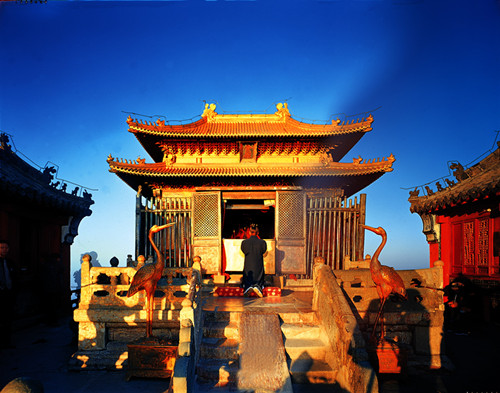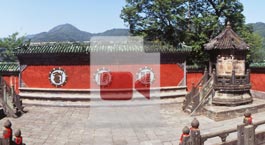Wudang Mountains: Harmony between man and nature
By Liu Kun and Zhang Heng ( chinadaily.com.cn )
Updated: 2014-07-31
The Wudang Mountains are initially known for their status as a Taoist shrine. Their natural landscape and geographic location are also sources that make the Taoist rite well-known.
It is said that the latitude 30 degrees north is an extraordinary parallel. It crosses lands on the earth with many natural wonders and human civilizations, such as Qomolangma, the highest mountain in the world, and the four great ancient civilizations: Mesopotamia, Egypt, India, and China. The Wudang Mountains, located at 32 degrees 23 minutes - 32 degrees 33 minutes north latitude, nurses Wudang culture, Taoism and tai chi philosophy, all denoting a theme of harmony, self-harmony, harmony between man and nature, and harmony between people and society.
The Wudang Mountains sit in Danjiangkou city in the northwest of Central China's Hubei province. It overlooks the thousands of miles of Shennongjia virgin forest in the south and has the Danjiangkou Reservoir, source of the South-to-North Water Diversion Project, in its north.
"Yin is in the north of waters, Yang is in the south of mountains, and tai chi is in Wudang," go the lyrics of a famous song. But what is tai chi? Some people believe that it is an abstract generalization of the endless movement cycles of the sun, the moon and stars. According to German philosopher Leibniz, it is the top mystery of the universe.
 |
| The Golden Palace on Wudang Mountains[Photo/Zhang Xing] |
In fact, glamour just comes from mystery. Ancient emperors and literati paid great attention to the Wudang Mountains due to its peculiar geography. Wudang Taoism is especially highly respected by the feudal emperors in the Ming Dynasty (1368-1644), with a saying that goes "to build the Forbidden City in the north and construct Wudang in the south."
According to historical records, in 1404, Emperor Zhu Di started to make construction plans for Wudang. Eight years later in 1412, Zhu started to overhaul the Wudang Mountains. A cluster of 33 buildings were completed in 12 years, stretching 70 km, which are the world’s largest religious buildings.
Biodiversity and regional ecological environmental protection are principles obeyed in the Wudang Mountains. At present, the forest coverage rate of the Wudang Mountains has reached 80 percent. More than 3,000 mu (200 hectares) of commercial forest have been transformed into ecological forest, and hundreds of old trees are being effectively protected.
As the world's cultural heritage, a national 5A scenic spot, and the water source area of the national water diversion project, the Wudang Mountains should deal with the problem of development and protection. Li Faping, committee secretary of the Wudang tourism economic zone, said that the local government will insist on the priority of ecological protection. The preserve of cultural heritage is also essential to the development of Wudang, Li added.
The Wudang Mountains also has another name - Taihe Mountains. Some experts interpret the Chinese words Taihe as a quiet state of mind, to truly understand the fundamental truth of the self and the world.
Contributed by Wang Liang and Jiang Yuanbo from Wudang Mountains Tourism Bureau
Edited by Zhang Qiong and Michael Thai



